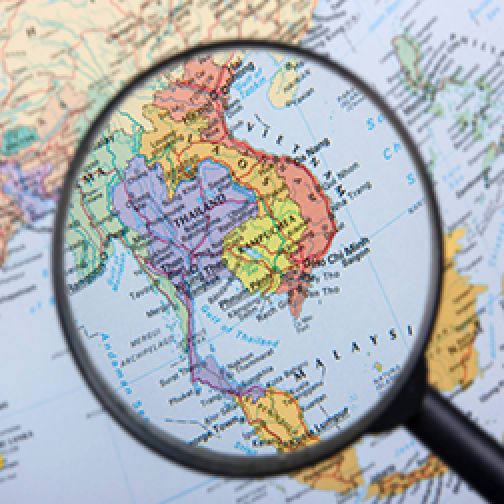Facts and figures
| GDP | $USD 5.49 billions |
| GDP per capita | $USD 5,868 |
| Currency | FJD (Fijian dollar $) |
| Imports | $USD 3.61 billions |
| Exports | $USD 3.03 billions |
| Main industries | tourism, sugar processing |
The 'Know Your Region' series is designed to support unit and individual professional military education on the South East Asian region. It's important for all serving members of our military to have a foundational knowledge of the countries and issues in the Indo-Pacific.
FIJI – ECONOMICS
On this page:
- Summary
- Economy and GDP
- Trade and Investment
- Trade Policies and trade with Australia
- Foreign Investment and Aid
Summary
Fiji has the second largest economy in the Pacific Islands Forum, with its economy largely sustained by tourism and agriculture. Impacts to its economy have included natural disasters such as cyclones and earthquakes. In 2016, Cyclone Winston had a devastating impact upon the country and its economy, and caused damage to homes, agricultural land and infrastructure. The damage was estimated at to be at 28% of Fiji’s GDP. Past political coups have also impacted the economy and this year, noting Fiji’s reliance on tourism, Fiji’s economy has been severely impacted by the COVID-19 pandemic.
Economy and GDP
Tourism is Fiji’s biggest source of revenue accounting for nearly 40% of its GDP. Since Cyclone Winston devastated the country, its economic recovery has been slow but consistent, supported by financial aid from countries across the Pacific region including Australia, Europe and the US. Two more cyclones in 2020 also had an impact on the country’s economy.
Fiji was ranked 150 in the world based upon its GDP at the end of 2019. Its gross national income per capita was estimated at USD $5390 in 2022. In 2020, the impact of COVID-19 on tourism contributed towards an economic decline of 19%, compared to 2019. Fiji’s revenue decreased by FJD$2.8 million (US$1.3 million) in the first quarter of this year, and currently one third of the workforce is unemployed. For more information on current and forecasted revenue from Fiji’s tourism, see Trading Economics site on Fiji's Tourism Revenues.
This GDP Annual Growth line graph demonstrates the dramatic decline:

Source: World Bank.Org
Agriculture is Fiji’s second largest economic contributor with both subsistence and commercial farming: the former producing cocoa, tropical fruit and fish; the latter producing sugar cane. According to the World Bank, in 2020 agriculture contributed to 14.89% of Fiji’s GDP. The economy is also supported by light-industry for local and regional use such as the construction of small boats. During the pandemic, initiatives were established to support those impacted by tourism to find new means of income as well as supporting the economy of their village community. This explainer gives some details:
Fiji has a 20-year national development policy. The strategic intent is to reduce government debt and improve current social and economic standards of living. This includes, but is not limited to, improving women’s place in society and supporting their empowerment, expanding the rural economy, providing education for all Fijian children, and improving food and nutrition availability and standards. This video explains the World Bank’s Work Plan for Fiji up to 2024:
For more information on Fiji’s GDP and economy, see the resources below:
- Videos
- Articles
- Fiji Economy Fact Sheet
- Lowy Institute: Pacific development Outlook for 2021
- National Debt of Fiji 2016-2020 and Prediction to 2026
- Fiji Islands: Economic Outline
- Lowy Institute: Diversifying Fiji’s economy: an agricultural opportunity outside ‘the norm’
- Fijian Government: 20-year National Development Plan
- Fiji’s new budget: significant fiscal challenges
- IMF Article IV mission to Fiji
- ANZ - Fiji's three speed economy
Trade and Investment
Historically, Fiji’s primary sources of trade were sandalwood, coconut oil, sea cucumbers and shipping. For a period of 200 years after their arrival in Fiji, European, Indian and British explorers and missionaries depleted the country of these resources. Today, Fiji’s most significant exports include bottled water, refined petroleum, fish, raw sugar and gold. Australia is among the main countries to whom Fiji exports its goods; others include the United States, New Zealand and Japan.
Over 50% of Fiji’s imports are sourced from Singapore. Imports include fuel, natural gas, vehicles, wheat, meat, rice, cane sugar and telecommunications equipment. Other importers include Australia, France, New Zealand and China.
Fiji has been a member of WTO since 14 January 1996.
For more information on Fiji’s trade and investment, see the information below:
- Videos
- Articles
Trade with Australia
Fiji and Australia share a strong bilateral relationship. Australia is one of Fiji’s largest trade and investment partners, with Australia importing gold and clothing from Fiji as well as Australians supporting its tourism and services industries. Fiji is Australia’s 11th largest market trader with Australia exporting mainly wheat, meat, paper, propane and butane to Fiji.
Most of Fiji’s products enter Australia duty free under the South Pacific Regional Trade and Economic Co-operation Agreement (SPARTECA). SPARTECA is a nonreciprocal trade agreement in which Australia and New Zealand offer duty-free and unrestricted access for specified products originating from the developing island member countries of the Pacific Islands Forum.
For more information on Fiji’s trade with Australia, see the following resources:
- Videos
- Podcasts
- Articles
Foreign Investment and Aid
Australia is Fiji’s largest bilateral development assistance partner. Our development cooperation program supports resilient, sustainable and equitable development in Fiji—a key hub for the Pacific region.
The relationship between Fiji and Australia is underpinned by close and practical cooperation. Development Programs in Fiji contribute to the achievement of Fiji’s National Development Plan and Fiji’s implementation of the Sustainable Development Goals.
Australia’s estimated Official Development Assistance (ODA) to Fiji for FY24-25 is A$123.1 million.
China has provided Fiji financial assistance since the 1970s, and their bi-lateral relationship has grown considerably since 2009. Fiji signed an MoU with China in 2018 as part of the One Belt One Road Initiative and to support Fiji’s economic growth.
Other countries which have provided investment and/or aid to Fiji are New Zealand, France, the European Union and the USA.
For more information on foreign investment and aid, see the following articles:
- Fiji Foreign Aid Data
- Australian development factsheet
- Tropical Cyclone Winston: Australia’s Humanitarian Assistance
- Cyclone Winston: Australia Pledges Another $10 Million in Aid for Fiji Victims
- China, Fiji ink MoU on Belt and Road Initiative cooperation
- Fijian Ministers at the Second Belt and Road Forum
- Why China is challenging Australia for influence over the Pacific Islands
- Which country gives the most aid to Pacific Island nations?
Discussion Questions:
- Fiji’s economy is heavily reliant on tourism, but has a supply side problem. What other economic opportunities might present themselves to diversify Fiji's economy? Could digital services present an opportunity?
- Recent natural and humanitarian disasters have heavily impacted the Fijian economy, and as such it will continue to rely in foreign aid to support its economy. Should Australia do more to assist Fiji in terms of aid provision? What might this look like? What risks are there from not increasing this support?
- Fiji is currently undertaking a 20-year economic development plan to improve standards of living across the nation. Should Australia place any conditions on its continued provision of foreign aid to Fiji?
Last Reviewed 09/2024
Know your region
Know Your Region series gives you a shortcut to understanding other nations in the Indo-Pacific region.









